Ambushed, Pt. 1 - Taylor Circa 74 Amplifier (Mahogany)
The amplifier I was never going to buy...
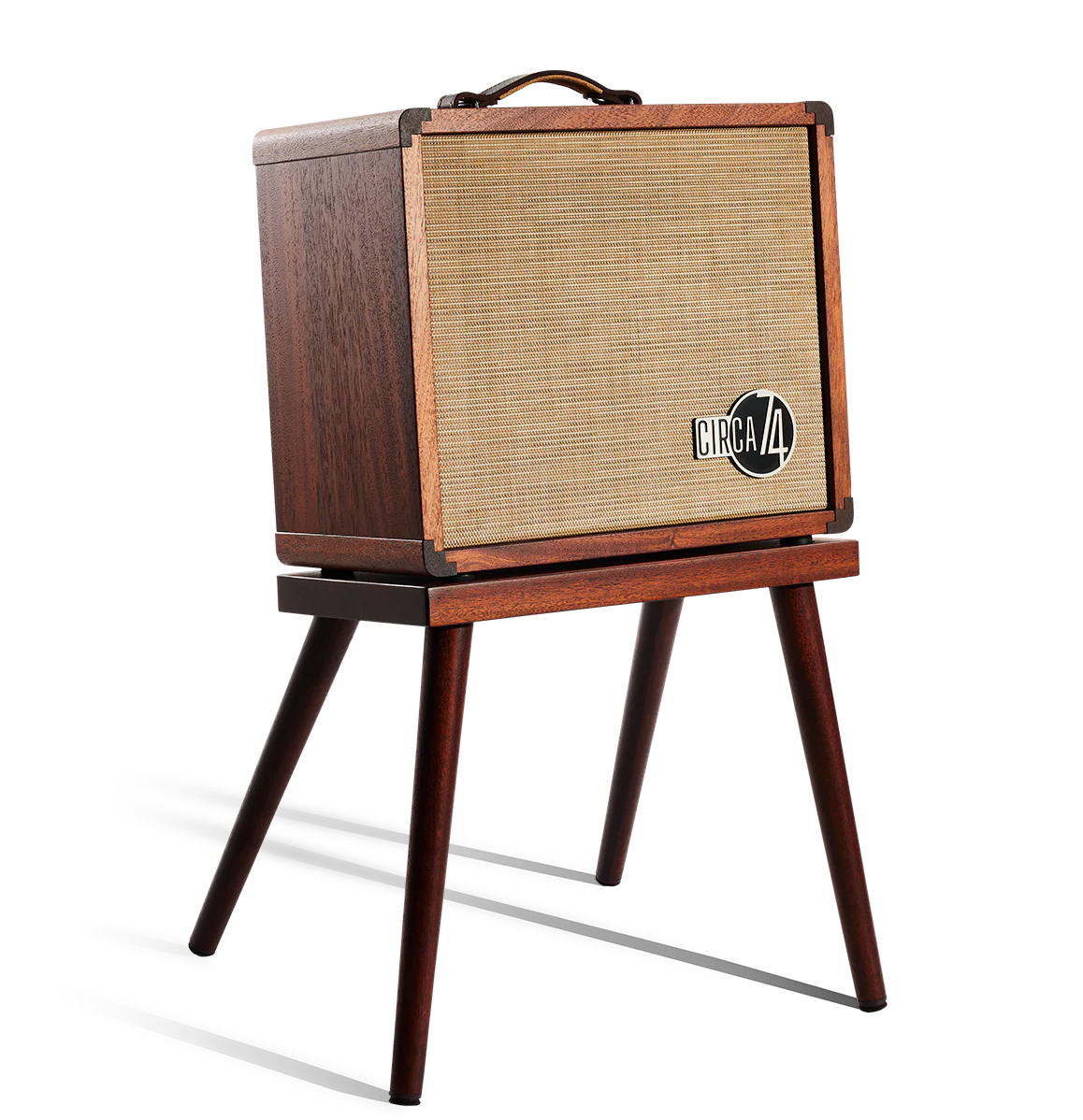
08/07/2025
You know how some things just sort of happen and you don't know why? That is exactly how I ended up owning this acoustic guitar amplifier. I was ambushed by it at a guitar dealer. I needed to check out the pickups on a couple of guitars and it was just sitting there in the high-end room at Guitar Center.
Why was I not going to buy it?
Well, there was the hype on the Internet. There has been plenty of that, and I am profoundly hype-adverse. In fact, pile on the hype and I run the other way. Then, frankly, the idea of a solid tone wood amplifier seemed too "tony" for me, possibly even snobby. It didn't help that the amp was expensive. I simply thought I would never shell out that much gelt for a premium acoustic guitar amp. If you haven't figure it out already, I'm not a person who likes to enter a room and blow everyone away with the sheer cost of my gear. Don't get me wrong: I love good guitars and gear that play well and look good and allow me to do what I need to do, but I'm not that guy who has to have the best of everything and show if off. And then there was the fact that I didn't see a need for a living room amp. My wife hasn't typically wanted my guitar gear out in the living room soa ll it goes in my rehearsal room, out to the studio, or in storage. As a result, I'm used to equipment in road cases and covered with Tolex. There is far less worry about cosmetic damage when it goes on the road when an item is covered in Tolex.
What changed my mind?
I was at Guitar Center with my lovely wife, trading in some gear to reduce my pile (too much stuff) and upgrading to fewer but better guitars. As I said, the amp was just there. While I was auditioning guitars and the dealer was appraising my trade-in stuff, I played through it to check out the guitars' different pickup systems. Once my stuff was evaluated, I had a chunk of money left over from my guitar deal. At that point i discovered that the amp was on sale. My wife heard me play the guitars through this amp and liked its sound and looks. And then she said it: "You don't have an acoustic amp, do you" Um, nope. "We should get this amp for the living room and to use at church." Ooops...
So, let me tell you about it.
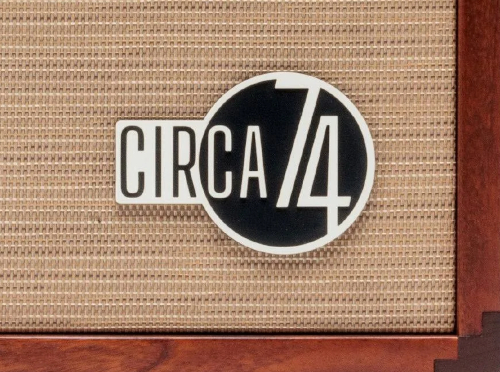
The Appearance:
The Taylor Circa 74 is slightly smaller than the ubiquitous Fender Princeton Reverb amp in all dimensions. At twenty-two pounds it weighs a third less, as well. The cabinet is built of nice, solid, furniture-grade mahogany which sports a smooth satin finish. The joinery is excellent and, as with most Taylor products, the amplifier exhibits impeccable fit and finish. The color scheme and aesthetics of the amplifier are sleek and elegant enough for it to fit comfortably in a home. The attractive, removable grille sports a huge logo and the handle is genuine leather. The package also includes a nice mid-century-styled stand with angled spindle legs and sockets to receive the rubber feet of the amplifier, giving it a stable platform and aiming it slighly upwards to prevent "beaming".
The Sound:
The basic sound with all EQ controls set at twelve o'clock is quite mellow. The amp has a full midrange and plenty of bass coming from its ten-inch speaker. There is a tiny bit of honk in the upper-mids, but you'll find that with all amps reproducing the typical pickups. The three-band EQ controls are smooth and quite useful for acoustic guitar. The room reverb is natural and unobtrusive at moderate levels and each channel offers its own send control. At the store, I played several Taylor guitars through the amp including a 724ce (all koa), a 714ce, and a 717e. At home I added a 354ce 12-string. The amp reproduced the sounds of the individual guitars, picking up and reproducing the acoustic differences between them. For instance, the 714ce at the store had a very quiet high E string and that came through the pickup and amp. The only time I experienced feedback was when I leaned directly in front of the amp at close range with a connected guitar. Frankly, the basic sound of the amp is better and more natural than that of the Marshall AS100D I owned previously, while the Circa 74 weighs about one-half the weight of the AS100D.
The Appeal:
Apparently this amplifier was designed to look good in a living room or formal atmosphere. As a matter of fact, it does fit into my living room well. Now, my living room doesn't feature carefully curated colonial reproduction furniture as my mother's did. Mine is more a blend of various styles. In the middle of this is the obligatory modern home theater. The amplifier's aesthetic is of simplicity and deliberate elegance with the controls hidden on the top-back like a '50s tweed Fender amp. The cream chicken-head knobs coordinate in a classy way and the symmetrical control layout contributes visually as well, but you'll rarely see it because the stand tilts the amp back so that the controls aren't visible. The basic model of this amp is housed in a nice mahogany cabinet. There is a Hawaiian koa edition and a Macassar ebony special edition of eight as well. They do command some pretty steep upcharges. I'll be real honest: I prefer the mahogany. It reminds me of a speaker cabinet my father built in the early 1960s. Whichever edition you choose, it might be a good idea to invest in a cover for the amp for lugging it around.
The Facilities:
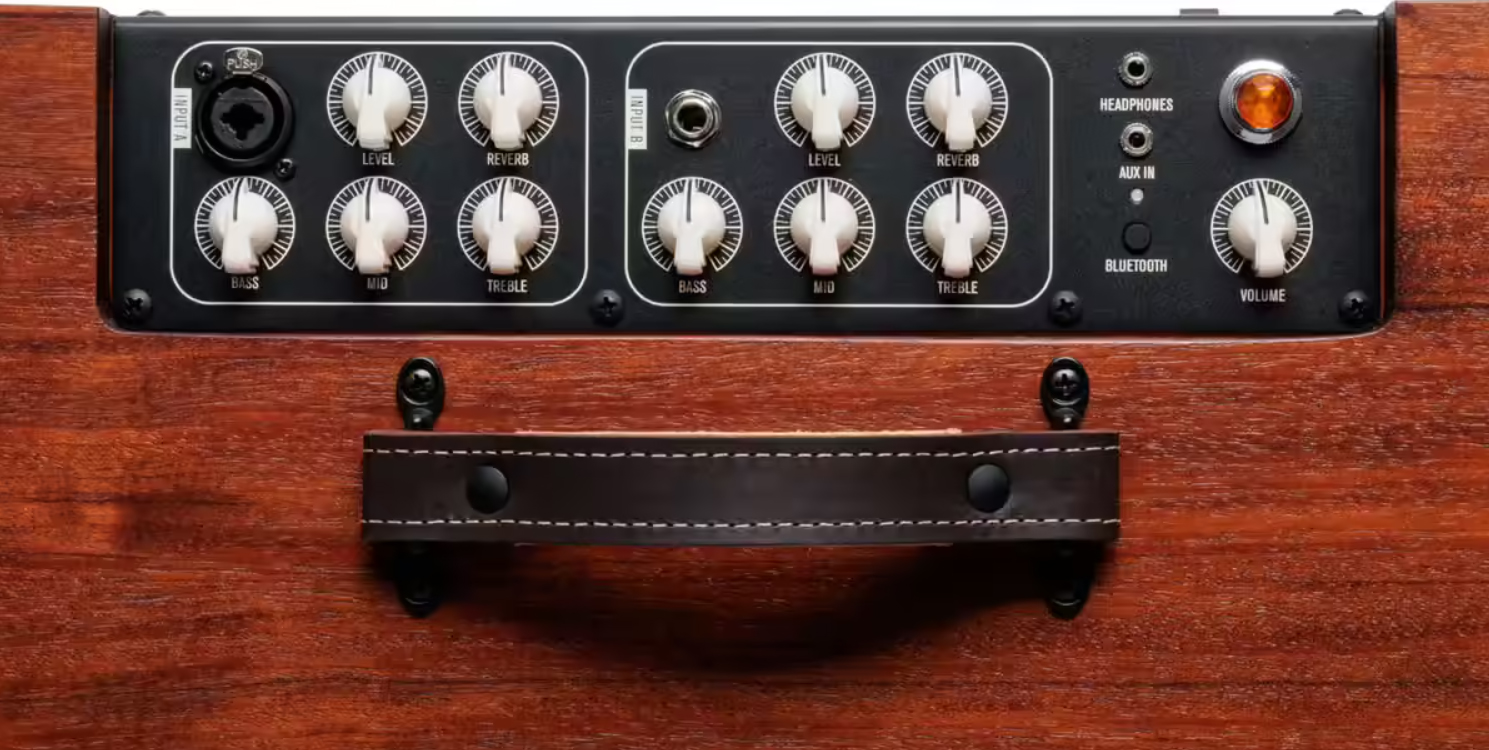
Image Courtesy Taylor
The Circa 74 amplifier features two channels, one of which offers the standard quarter-inch, unbalanced input for guitar and the other offers a combo XLR low impedance and quarter-inch unbalanced, high impedance input for either a mic or another guitar. Each channel has a volume control, a three band EQ, and a reverb send. In the master section there is an auxiliary input with an eighth-inch jack, a Bluetooth input with pairing button and LED, an eighth-inch headphone jack, and a large amber jewel power lamp. On the back panel are an XLR direct out to allow you to send the output signal to a PA console and a quarter-inch out to allow you to send the signal to another powered speaker device. I called Taylor and they said those outputs are post-EQ. I should take it to work and check that. Rounding out the back panel are the power switch, fuse, and the IEC power socket. I was interested to see that the amplifier can accept 100-240VAC at 50-60 Hz., so you don't have to worry about travel to Europe.
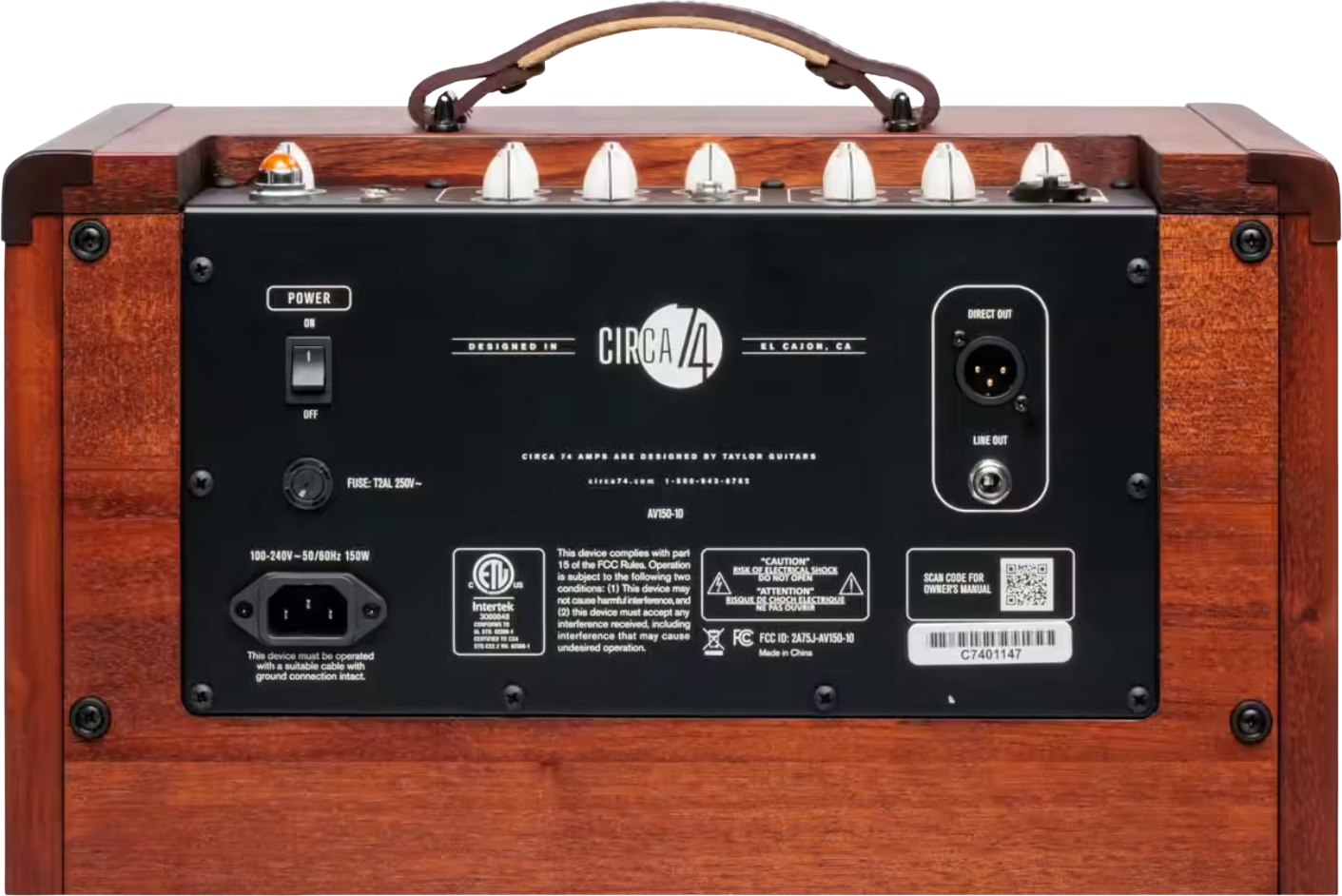
Image Courtesy Taylor
Possible Detractions:
The are no feedback resistance facilities such as a notch filter. There is no phantom power for the mic input. There are no effects loops. The are no volume controls for the line or Bluetooth inputs. You must balance them against the inputs using the master volume, channel volumes, and volume controls on the devices. However, I get it. All those extra controls would begin to pile up and would go against the basic visual and operational aesthetic of simplicity. For phantom power, grab a cheap inline supply from one of the big box stores and you are set. Still and all, if those facilities are important to you, you won't find them here.
So, what's the final verdict?
I actually really like this amplifier. The sound is clean and attractive and the appearance is elegant. Being a recording engineer I am prone to knob twiddling, but the basic collection of controls kind of thwarts that tendency and forces me to simply play. Honestly, I never thought I'd play through an amplifier in my living room, but there is an application: as the sun sets and the room fills with hues of red and blue, playing through the amp with a touch of reverb can float you away a bit.
So, what else ambushed me? Head over HERE to find out!
Specifications:
Model: AV150-10 (Acoustic-Vocal, 150 watts, 10-inch speaker)
150 Watts
Solid wood case and stand, mahogany or koa ($400 upcharge)
2 channels, one with balanced/unbalanced combo XLR-1/4" input (no p48) the other with 1/4" input
Nice, three-band EQ, volume control, and reverb send per channel
Master volume
Headphone out 1/8"
Direct and Line outs
Aux in 1/8"
Bluetooth in
Mid-Century styled stand with legs like the speaker my father built
One year warranty, unless you register the product within ninety days, which extends it to five years total
Cabinet Dimensions: 16.5" x 9" x 14"
Stand Dimensions: 16.75" x 9.25" x 16"
Weight: 22 lbs. (amp without stand)
Designed in America, made in China.
What's in the Box:
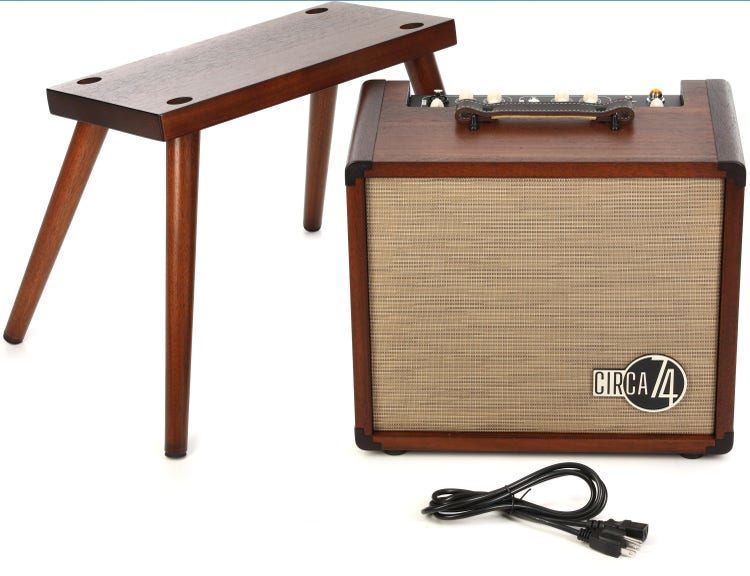
Image Courtesy Sweetwater
Oh, and what's in a name? In 1974, Bob Taylor and Bruce Listug went together and bought the tiny "American Dream" small shop guitar luthiery they both worked for. Starting there, the two founded Taylor-Listug, Inc., doing business as Taylor Guitars.
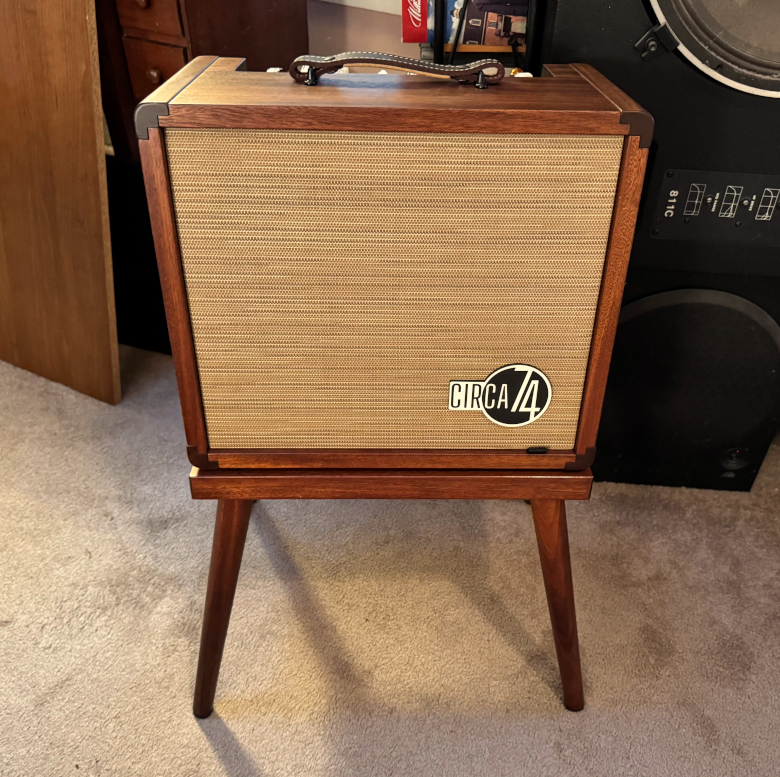
My Example
CIRCA 74 WEBSITE
= =
=






